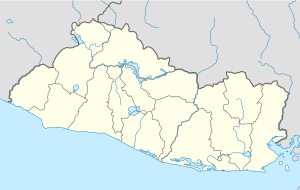Nahuizalco
| Nahuizalco | ||
|---|---|---|
|
Coordinates: 13 ° 47 ′ N , 89 ° 44 ′ W Nahuizalco on the map of El Salvador
|
||
| Basic data | ||
| Country | El Salvador | |
| Department | Sonata | |
| Residents | 49,081 (2007) | |
| Detailed data | ||
| surface | 34.32 | |
| height | 540 m | |
| Time zone | UTC −6 | |
| City Presidency | Jorge Willer Patriz Castañeda ( FMLN- CD), 2009–2012 | |
Nahuizalco (formerly Nahuitzalco , Nawat : Nawitzalku ) is a municipality (administrative unit) of the Sonsonate department in El Salvador . It is located on the "Route of Flowers" (Ruta de las Flores), 9 km from Sonsonate and 74 km from San Salvador , at 540 m above sea level on the south side of the Apaneca and Ilamatepec mountain range. According to the last census of 2007, it has 49,081 inhabitants.
history
The area of Nahuizalco was probably due to the before 900 Nahua -Ethnie Pipil settled. From 1200 to 1528 it belonged to the Cuzcatlan dominion .
The Nawat name Nawitzalku consists of two words, the numeral nawi , "four" and the place name Itzalku ( Izalco ). This in turn is composed of the roots itz , “ obsidian ”, (k) al , “house” and the locative ending -ku ( Nahuatl -co ) and can be roughly translated as “place of obsidian houses”. According to a chronicle of the Franciscan Relación Breve y Verdadera from 1586, Nahuizalco got its name because it once had four times as many inhabitants as the neighboring Izalco. In an information sheet from the municipality of Nahuizalco from October 15, 1859, however, it says that four families from Izalco founded the place after the conquest by the Spaniards and that is how the place got its name.
At the time of the Spanish colony, Nahuizalco was part of the province of Izalco. According to the Chronicle Relación Breve y Verdadera of 1586, the village had less than 200 inhabitants.
From 1821 to 1823 Nahuizalco belonged to Guatemala and in 1824 came to the department of Sonsonate . By 1856 the community had 4,983 inhabitants.
In 1932 Pipil farmers from Nahuizalco took part in the uprising against the large landowners and the military rule of General Maximiliano Hernández Martínez . After the suppression of the uprising, the Matanza , a massacre that killed around 30,000 people in all of El Salvador in early 1932, over a quarter of the total population in Izalco, almost every man over 12 who could not escape. The mass shootings lasted for about a month. The Nawat language of the Pipil was subsequently banned and brought to the brink of extinction within a few decades.
In 1955 Nahuizalco received city rights.
The church was severely damaged in the 2001 earthquake. It was then restored again.
Pipil culture today
Nahuizalco is one of the last places where the Pipil language Nawat can occasionally be heard. Due to the efforts of the indigenous organization Asociación Coordinadora de Comunidades Indígenas de El Salvador (ACCIES) and the University of Don Bosco in San Salvador , teaching is carried out in individual schools in the Sonsonate Nawat department despite the lack of state programs. In 2008 in Nahuizalco, 500 students learned Nawat from three teachers at one school, and another 255 students in three other locations within the municipality. The project has been running since 2003.
economy
Nahuizalco is dominated by agriculture. Traditional crafts are basket-making and mat-weaving. Nahuizalco has a night-time, candle-lit market where the wickerwork is sold until 10 p.m.
Attractions
Nahuizalco has a colonial church ( San Juan Bautista ) with a patronage festival from June 20th to 25th.
Individual evidence
- ↑ Resultados Alcaldes Electos en El Salvador para 2009-2012 ( Memento of the original from December 28, 2010 in the Internet Archive ) Info: The archive link was inserted automatically and has not yet been checked. Please check the original and archive link according to the instructions and then remove this notice.
- ^ Iniciativa para la Recuperación del Idioma Náhuat: IRIN
- ^ Paul D. Almeida: Organizational expansion, liberalization reversals and radicalized collective action. In: Harland Prechel (ed.): Politics and globalization 15, 2007, pp 57-97.
- ↑ Jeffrey Gould y Carlos Henríquez Consalvi: Video "1932. Cicatrices de la memoria". New York: First Run / Icarus Films, 2002. Film review 1932 - La memoria toma la palabra. ( Memento of the original from March 10, 2009 in the Internet Archive ) Info: The archive link was automatically inserted and not yet checked. Please check the original and archive link according to the instructions and then remove this notice.
- ↑ Memoria Curso - Taller Nacional sobre Derechos Humanos y Pueblos Indígenas en El Salvador ( Memento of the original from December 19, 2011 in the Internet Archive ) Info: The archive link was inserted automatically and has not yet been checked. Please check the original and archive link according to the instructions and then remove this notice. (PDF; 466 kB)
- ↑ Edgardo Ayala, ipsnoticias.net, 14 de octubre 2009: Lengua indígena se niega a morir ( Memento of the original from July 3, 2012 in the web archive archive.today ) Info: The archive link was automatically inserted and not yet checked. Please check the original and archive link according to the instructions and then remove this notice.
- ^ Jorge E. Lemus: Un modelo de revitalización lingüística - el caso del náhuat o pipil de El Salvador. (PDF; 897 kB) Experiencias educativas de publicación No. 2, March 2008. ( Memento of July 8, 2014 in the Internet Archive )



